Wilkinson, John Edward Frank
unknown 1945-12-18
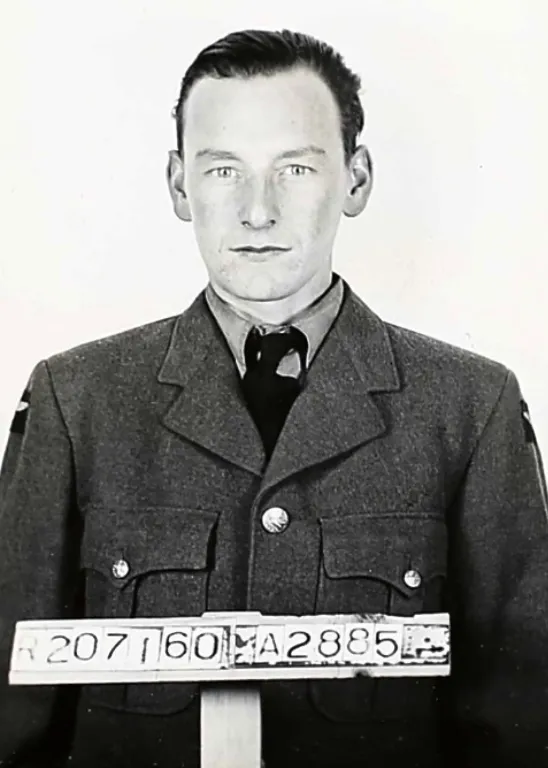

Birth Date: 1923
Born:
Son of John Vernon Wilkinson and Annie Wilkinson, of Willow Beach, Ontario, Canada.
Home:
Enlistment:
Enlistment Date: Unknown
Service
RCAF
Unit
437 Sqn- Squadron
Omnia Passim Anything anywhere
Base
Rank
Pilot Officer
Position
Pilot Officer
Service Numbers
J/95532
437 Sqn Omnia Passim ("Husky")
History of the Squadron during World War II (Aircraft: Dakota III, IV)
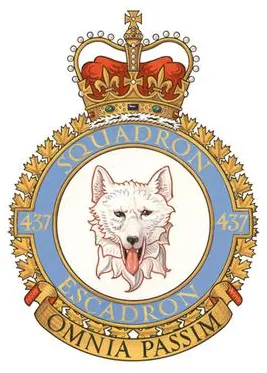
No. 437 was the 32nd RCAF squadron formed overseas in WWII. It was the first of three transport squadrons. It was inaugurated on September 14, 1944 at Blakehill Farm, Wiltshire, England  . It flew Dakota aircraft, and its first operation was MARKET GARDEN, the airborne assault on Arnhem. It carried airborne troops and later was involved in resupply missions to the beleaguered Allied forces, losing 4 out of 10 aircraft involved. On 24 March 1945 the squadron took part in the airborne crossing of the Rhine river at Wesel (Operation VARSITY), towing 24 Horsa gliders with troops and equipment. After the end of hostilities the squadron provided transport services for Canadian units in Britain and Europe. It was finally disbanded at Odiham, Hampshire
. It flew Dakota aircraft, and its first operation was MARKET GARDEN, the airborne assault on Arnhem. It carried airborne troops and later was involved in resupply missions to the beleaguered Allied forces, losing 4 out of 10 aircraft involved. On 24 March 1945 the squadron took part in the airborne crossing of the Rhine river at Wesel (Operation VARSITY), towing 24 Horsa gliders with troops and equipment. After the end of hostilities the squadron provided transport services for Canadian units in Britain and Europe. It was finally disbanded at Odiham, Hampshire  on June 15, 1946.
on June 15, 1946.
Overall, the squadron flew11,625 sorties, adding up to 32,355 operational hours. 14 aircraft were lost and 17 aircrew, of whom 2 were killed, 14 missing and 1 wounded. Awards gained by the squadron were 1 OBE, 8 DFCs, 2 AFCs 1 DFM, 1 MiD and 3 King's Commendations. Battle Honours were France and Germany 1944-45, Arnhem, Rhine.Wikipedia, Kostenuk and Griffin
Maps for Movements of 437 Squadron 1944-46
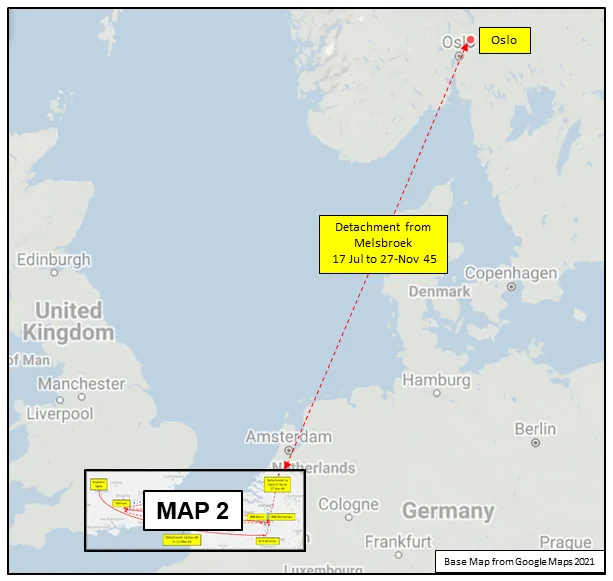 | 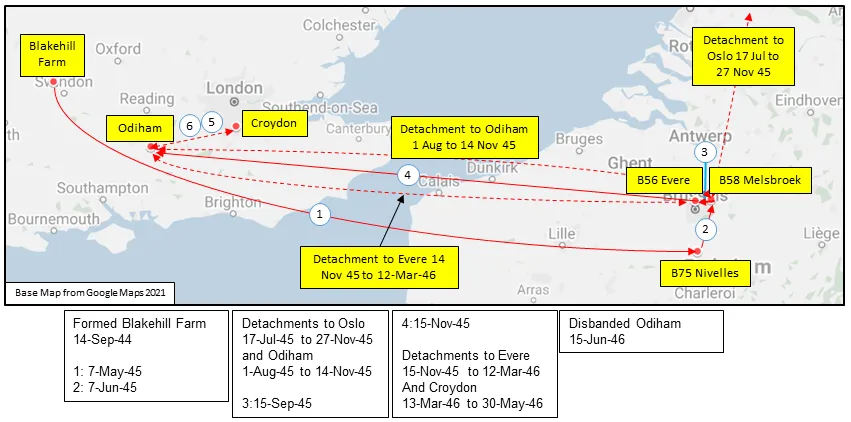 |
437 Squadron History Summary 1944-46
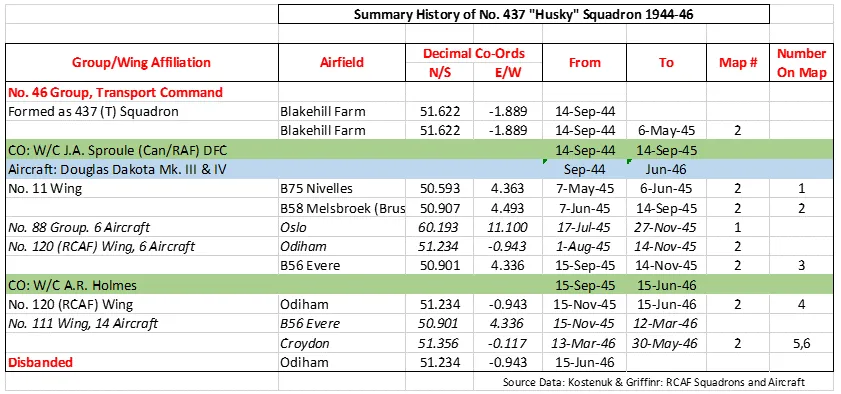
History of the Squadron Post-WWII (Aircraft: Yukon, Husky, Polaris)
The squadron was reformed at Trenton, Ontario  on 1 October 1961. It has remained at Trenton ever since. It was originally equipped with CC-106 Yukon. It was re-equipped with the CC-137 Husky (modified Boeing 707) in 1972. While operating the Husky it provided Air to Air Refueling in addition to transport services. Two aircraft out of the fleet of five were modified to serve as refueling tankers in mid-1972 to meet a requirement to support the CF-5 tactical fighter. At the end of the useful life of the B707 in 1997, 437 Squadron was equipped with modified Airbus A-310 aircraft (CC-150 Polaris). The Squadron’s primary roles are long-range transport of personnel and equipment, air-to-air refueling of fighter aircraft and VIP transport. The Squadron occasionally performs aeromedical evacuation roles. Two CC-150 air-to-air refueling tankers were deployed to support Operation MOBILE during the 2011 military intervention in Libya. Canadian CF-188 fighter jets that enforce the no-fly zone over Libya under Operation ODYSSEY DAWN and Operation UNIFIED PROTECTOR were refueled by 437 Squadron.
on 1 October 1961. It has remained at Trenton ever since. It was originally equipped with CC-106 Yukon. It was re-equipped with the CC-137 Husky (modified Boeing 707) in 1972. While operating the Husky it provided Air to Air Refueling in addition to transport services. Two aircraft out of the fleet of five were modified to serve as refueling tankers in mid-1972 to meet a requirement to support the CF-5 tactical fighter. At the end of the useful life of the B707 in 1997, 437 Squadron was equipped with modified Airbus A-310 aircraft (CC-150 Polaris). The Squadron’s primary roles are long-range transport of personnel and equipment, air-to-air refueling of fighter aircraft and VIP transport. The Squadron occasionally performs aeromedical evacuation roles. Two CC-150 air-to-air refueling tankers were deployed to support Operation MOBILE during the 2011 military intervention in Libya. Canadian CF-188 fighter jets that enforce the no-fly zone over Libya under Operation ODYSSEY DAWN and Operation UNIFIED PROTECTOR were refueled by 437 Squadron.
437 Transport Squadron frequently supports government dignitaries while on official visits, including the Prime Minister of Canada and Queen Elizabeth II during Royal tours of Canada. In June and July 2011 the squadron provided transportation for the Duke and Duchess of Cambridge as they toured Canada and the United States.
 Canadian Virtual War Memorial
Canadian Virtual War Memorial